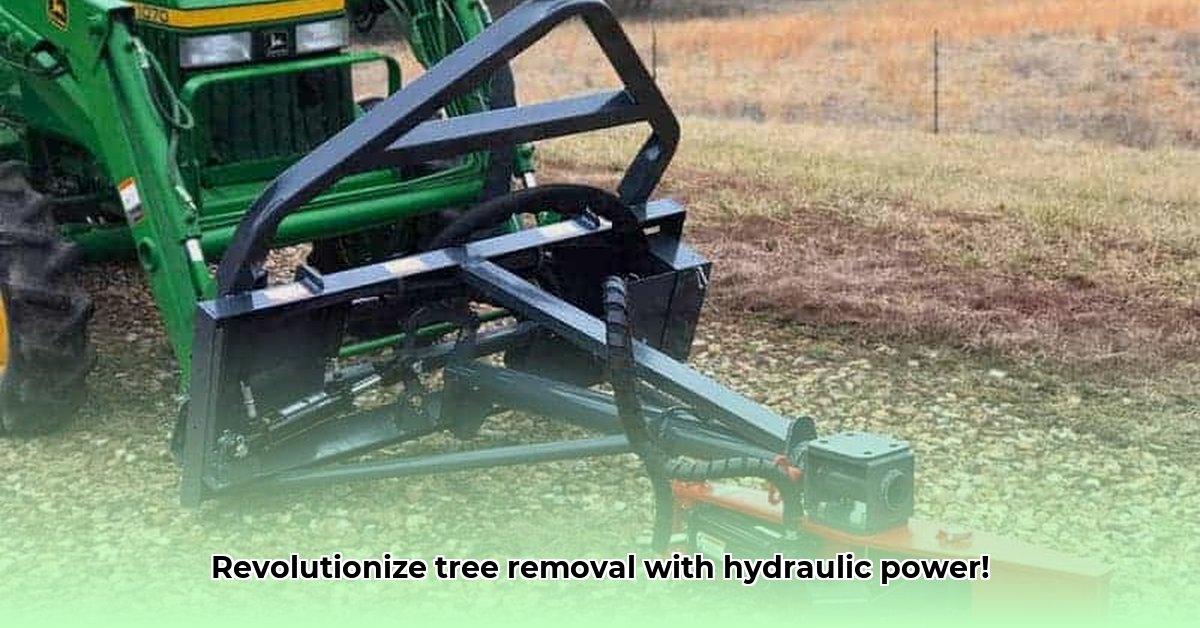
Hydraulic Tree Saws for Tractors: A Sustainable Approach to Land Management
Facing the challenge of invasive species removal or simply needing more efficient land clearing? Hydraulic tree saws, tractor-mounted attachments, offer a powerful solution. This article explores their capabilities, compares them to alternative methods, and details strategies for sustainable implementation. Whether you're a farmer prioritizing efficiency or a landowner focused on environmental responsibility, this technology deserves your consideration. For more on stump removal, see our guide on tractor stump removal.
How Hydraulic Tree Saws Work
Hydraulic tree saws leverage your tractor's existing hydraulic system, eliminating the need for separate power sources. The saw's blade, often featuring a robust design, is directly powered by the tractor's hydraulics for efficient and powerful cutting. Many models incorporate features like pushing bars for cutting and hydraulic grapples for maneuvering felled trees. This integrated system offers a significant advantage over manual methods in terms of speed, power, and operator comfort. The specific design (e.g., inclusion of a grapple) impacts workflow efficiency; careful consideration of these features is paramount during the selection process.
Comparing Hydraulic Tree Saws to Alternatives
Several methods exist for tree removal, each with trade-offs. Let's compare:
| Method | Efficiency | Initial Cost | Operating Cost | Environmental Impact | Safety |
|---|---|---|---|---|---|
| Hydraulic Tree Saw | Very High | High | Moderate | Moderate (fuel use, compaction) | Moderate |
| Manual Cutting | Low | Low | Low | Low | Low (but potentially high risk) |
| Chemical Control | Moderate | Low | Low | Potentially High (chemical runoff) | High (chemical-dependent) |
Hydraulic saws deliver significantly higher efficiency than manual cutting, translating to reduced labor costs and the feasibility of tackling larger areas. However, the initial investment is substantial. A comprehensive cost-benefit analysis, factoring in long-term fuel and maintenance, is crucial before purchase. While hydraulic saws use fuel—contributing to their moderate environmental impact—their speed can result in lower overall emissions than repeated manual cutting passes. Soil compaction remains a key concern, necessitating careful operation and consideration of soil conditions. Chemical control, though potentially cheaper upfront, presents substantial environmental risks through runoff. Safety also varies significantly, with manual methods posing higher risks to the operator than the relatively moderate risks associated with hydraulic saws.
Sustainability Considerations: Minimizing the Environmental Footprint
While hydraulic tree saws offer efficiency, their fuel use and potential for soil compaction require careful management. Minimizing these impacts involves strategic implementation:
- Targeted application: Use the saw only on appropriate terrain, avoiding excessively wet or dry conditions to minimize compaction.
- Precision cutting: Careful operation reduces damage to surrounding vegetation.
- Fuel efficiency: Proper tractor maintenance, including regular fluid checks and prompt leak repairs, is crucial to optimize fuel consumption. Explore fuel-efficient tractor models.
- Responsible fluid disposal: Adhere to local regulations for the proper disposal of used hydraulic fluids and consider biodegradable alternatives when feasible.
Implementing Hydraulic Tree Saws: A Step-by-Step Guide
Strategic implementation is key to realizing the full benefits of hydraulic tree saws:
- Assess needs: Evaluate the scale of the project, the types of trees, and the terrain to select the appropriate saw model.
- Conduct a cost-benefit analysis: Compare initial investment costs against long-term savings in labor, fuel, and potential environmental remediation.
- Pilot program: Start with a small-scale trial to gather real-world data on efficiency and cost-effectiveness.
- Seek expert advice: Consult with forestry or agricultural professionals for tailored recommendations.
- Explore funding: Investigate government grants or programs supporting sustainable land management practices.
Future Directions in Hydraulic Saw Technology
Ongoing advancements promise further improvements:
- Fuel efficiency: Research into alternative fuels and more efficient engine designs will reduce fuel consumption and environmental impact.
- Electric models: The development of electric-powered hydraulic saws offers a route to zero-emission operation.
- Reduced soil compaction: Innovative designs are being explored to minimize soil disturbance.
Conclusion: A Powerful Tool for Sustainable Land Management
Hydraulic tree saws represent a significant advancement in land management, offering increased efficiency and the potential for substantial environmental gains. However, responsible implementation, mindful of fuel consumption and soil compaction, is crucial. By following best practices and staying informed about technological advancements, landowners and farmers can leverage this technology to achieve both improved productivity and enhanced environmental stewardship. The future of sustainable land management incorporates these powerful tools, and proactive planning ensures responsible and efficient land clearing.